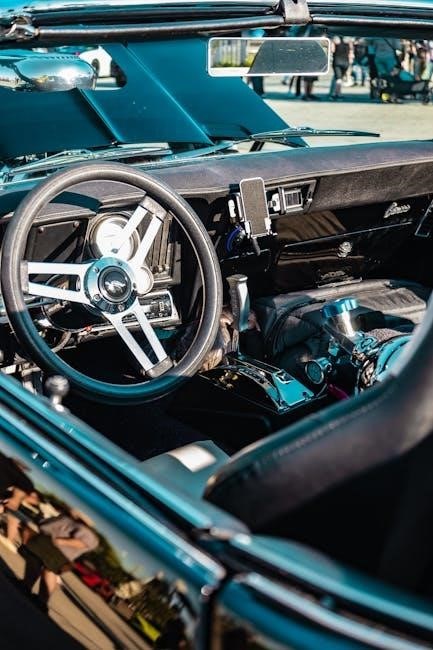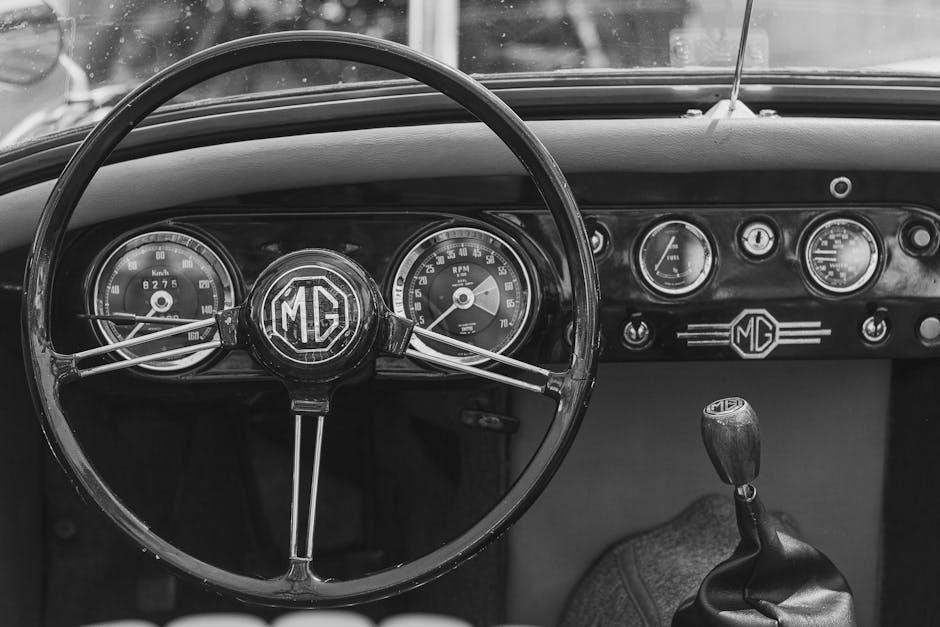
A 9-speed manual transmission offers precise gear control, optimizing performance and fuel efficiency. Designed for driver engagement, it provides smooth shifting and adaptable gearing for various driving conditions.
1.1 What is a 9-Speed Manual Transmission?
A 9-speed manual transmission is a type of gearbox that offers nine distinct gear ratios. It allows drivers to manually shift gears using a clutch pedal and gearshift, providing precise control over the vehicle’s speed and torque. With nine gears, the transmission can optimize engine performance and fuel efficiency across various driving conditions, from city driving to high-speed cruising. This setup enhances acceleration by keeping engine RPMs within an optimal range and improves fuel economy by reducing unnecessary engine strain at higher speeds. The additional gears also enable smoother transitions between speeds, making the driving experience more refined and responsive. Overall, a 9-speed manual transmission strikes a balance between performance and efficiency, appealing to drivers who value both power and precision.
1.2 Benefits of a 9-Speed Manual Transmission
The 9-speed manual transmission provides enhanced driving control and efficiency. By offering nine gears, it ensures optimal engine performance across various speeds, improving both acceleration and fuel economy. Drivers can maintain engine RPMs within the power band, reducing unnecessary strain and enhancing responsiveness. This setup is particularly advantageous in diverse driving conditions, such as city traffic and highway cruising. Additionally, the manual transmission fosters a more engaging and connected driving experience, appealing to enthusiasts who value precision and control. Its compact design and lightweight construction further contribute to overall vehicle efficiency, making it a preferred choice for those seeking a balance between performance and practicality.

Design and Components of a 9-Speed Manual Transmission
A 9-speed manual transmission features a complex gear system, bearings, and lightweight materials. Its compact design ensures smooth operation and efficient power delivery across all gears.
2.1 Gear Ratio System in a 9-Speed Transmission
The 9-speed manual transmission incorporates a meticulously designed gear ratio system, offering a wide range of ratios for optimal performance across various driving scenarios. The closely spaced gears ensure smooth transitions, minimizing engine strain during acceleration. This setup allows drivers to maintain optimal engine speed, enhancing both power delivery and fuel efficiency. The gear ratios are typically arranged to provide ample torque in lower gears for acceleration and higher gears for cruising efficiency. This balanced approach ensures that the transmission adapts seamlessly to different driving conditions, from city traffic to highway speeds, making it versatile and driver-friendly.
2.2 Key Components of a 9-Speed Manual Transmission
The 9-speed manual transmission comprises several critical components, each playing a vital role in its operation. The gearbox houses the intricate system of gears, bearings, and shafts that facilitate power transfer. The clutch is essential for engaging and disengaging the engine from the transmission. Synchronizers ensure smooth gear transitions by equalizing speed between gears. The shift mechanism, including the gear lever and linkage, allows the driver to manually select gears. Bearings reduce friction and support moving parts, while seals and gaskets prevent fluid leaks. Together, these components work in harmony to deliver precise control and efficient power delivery, making the 9-speed manual transmission both reliable and performance-oriented.
2.3 Role of Bearings and Gears in the Transmission
In a 9-speed manual transmission, gears and bearings are fundamental to its operation. Gears transmit power between the engine and wheels, with each gear ratio providing optimal speed and torque for specific driving conditions. Bearings, such as ball bearings and roller bearings, support the gears and shafts, reducing friction and enabling smooth rotation. They also absorb vibrations, ensuring quiet and efficient operation. The precise engineering of gears and bearings ensures durability and minimal wear, while their interaction allows for seamless shifting between gears. This combination of gears and bearings is crucial for maintaining the transmission’s performance, reliability, and longevity.

Operation and Shifting Mechanism
The 9-speed manual transmission operates through a clutch pedal and gearshift, enabling drivers to manually select gears. Synchronizers ensure smooth transitions between gear ratios for optimal performance.
3.1 How a 9-Speed Manual Transmission Works
A 9-speed manual transmission functions by allowing the driver to manually select gear ratios using the clutch pedal and gearshift. The clutch disengages the engine from the transmission, enabling smooth gear transitions. Synchronizers within the transmission ensure that gears mesh properly, reducing wear and tear. The driver monitors engine speed and load to determine the optimal gear, enhancing both performance and efficiency. This system provides precise control over power delivery, making it ideal for drivers seeking an engaging experience. The additional gears allow for better optimization of engine performance across various driving conditions, from low-speed city driving to high-speed highway cruising.
3.2 The Shifting Process in a 9-Speed Transmission
The shifting process in a 9-speed manual transmission involves pressing the clutch pedal to disengage the engine from the current gear. The driver then moves the gearshift to the desired gear, guided by the gate positions. Synchronizers within the transmission ensure smooth engagement by matching gear speeds. The clutch pedal is gradually released to re-engage the engine with the new gear. The process requires coordination between the clutch, accelerator, and gearshift, especially during acceleration or deceleration. The additional gears in a 9-speed transmission allow for finer control over engine speed, optimizing both performance and fuel efficiency. This precise shifting mechanism enhances driver control and driving dynamics.
3.3 Role of the Clutch in Manual Transmission
The clutch plays a pivotal role in a 9-speed manual transmission by disconnecting the engine from the transmission, enabling smooth gear changes. When the driver presses the clutch pedal, it releases the friction plate, interrupting power flow. This allows the gears to shift without grinding or damage. The clutch also helps in controlling engine speed during acceleration or deceleration, ensuring seamless transitions between gears. Proper clutch operation requires precise timing and pedal control, especially in stop-and-go traffic or uphill driving. The clutch system is essential for manual transmissions, enabling drivers to engage and disengage gears effectively while maintaining control over the vehicle’s performance and responsiveness.

Performance and Efficiency
A 9-speed manual transmission enhances driving performance by optimizing engine RPM and torque delivery, improving acceleration and responsiveness. It also boosts fuel efficiency, especially in urban driving.
4.1 Acceleration and Power Delivery
A 9-speed manual transmission delivers exceptional acceleration by maintaining optimal engine RPM during shifts. With tightly spaced gear ratios, it ensures maximum power delivery across the entire rev range. This setup minimizes torque loss, enabling quicker acceleration and better responsiveness in both city driving and high-speed conditions. The precise control over gearing allows drivers to extract the engine’s full potential, making it ideal for performance-oriented vehicles. Additionally, the transmission’s design ensures smooth power transitions, reducing hesitation and enhancing the overall driving experience. This makes the 9-speed manual a preferred choice for enthusiasts seeking both performance and efficiency.

4.2 Fuel Efficiency with a 9-Speed Manual Transmission
The 9-speed manual transmission enhances fuel efficiency by optimizing engine speed through a wide range of gear ratios. With more gears, the engine operates within its most efficient RPM range, reducing fuel consumption. This is particularly beneficial in both city driving, where frequent acceleration and deceleration occur, and on highways, where higher gears maintain low engine speeds. Compared to automatic transmissions, the manual gearbox provides better control, allowing drivers to shift gears precisely for optimal economy. Additionally, the precise engineering of the transmission minimizes energy loss, further improving mileage. This makes the 9-speed manual an excellent choice for drivers seeking to balance performance and fuel efficiency.
4.3 Comparison with Automatic and Dual-Clutch Transmissions
The 9-speed manual transmission stands out against automatic and dual-clutch systems by offering superior driver control and engagement. While automatics prioritize convenience, they often lack the precision and fuel efficiency of a manual. Dual-clutch transmissions provide quick shifts but can be less smooth in low-speed situations. Manuals, however, deliver consistent performance and better mileage, especially in skilled hands. The 9-speed manual excels in both city and highway driving, with its wide gear range ensuring optimal engine performance. Despite advancements in automatics, the manual remains a preferred choice for enthusiasts seeking a direct driving experience and maximum efficiency. This comparison highlights the unique advantages of the 9-speed manual in modern vehicles.

Advantages of a 9-Speed Manual Transmission
A 9-speed manual transmission offers enhanced control, improved fuel efficiency, and a more engaging driving experience compared to traditional manuals, making it ideal for diverse driving conditions.
5.1 Better Control Over Gearing
A 9-speed manual transmission provides drivers with superior control over gearing, allowing precise matching of engine speed to driving conditions. This results in smoother acceleration and better fuel economy. With nine gears, drivers can maintain optimal RPM ranges, enhancing both performance and efficiency. The additional gears enable finer control during acceleration, reducing the need for frequent shifting and minimizing wear on the engine. This level of control is particularly beneficial in varied driving scenarios, such as city traffic or highway cruising. The ability to select the perfect gear for any situation ensures a more engaging and efficient driving experience, making it ideal for enthusiasts and everyday drivers alike.
5.2 Improved Fuel Economy
The 9-speed manual transmission is engineered to enhance fuel efficiency by optimizing gear ratios for a wide range of driving conditions. With more gears available, the engine operates within its most efficient RPM range, reducing fuel consumption. This is particularly beneficial in both city driving, where frequent stop-and-go traffic can lower efficiency, and on highways, where maintaining a consistent speed is key. The precise control over gearing allows drivers to shift into the most fuel-efficient gear for any situation, contributing to better mileage. As a result, vehicles equipped with a 9-speed manual transmission often achieve superior fuel economy compared to those with fewer gears, making it a practical choice for eco-conscious drivers.
5.3 Enhanced Driving Experience
The 9-speed manual transmission elevates the driving experience by offering precise control and smooth gear transitions. With more gears at their disposal, drivers can tailor their shifting to match the road conditions, whether navigating city streets or cruising on highways. This level of control fosters a deeper connection between the driver and the vehicle, creating a more engaging and immersive driving experience. The ability to select the perfect gear for any situation enhances responsiveness and driver satisfaction. Additionally, the rhythmic process of shifting through nine gears adds a layer of enjoyment, making every drive feel purposeful and rewarding. This makes the 9-speed manual a preferred choice for enthusiasts who value both performance and driving pleasure.

Disadvantages of a 9-Speed Manual Transmission
The 9-speed manual transmission’s complexity can lead to higher maintenance costs and mechanical issues. Its intricate gear system may also limit availability in certain vehicle models.
6.1 Complexity of the Gear System
The 9-speed manual transmission features a sophisticated gear system with multiple components, making it more complex than lower-speed transmissions. This complexity can lead to increased maintenance costs and potential mechanical issues. Additionally, the intricate design requires precise manufacturing and assembly, which can be challenging and error-prone. The higher number of gears also means more parts, such as bearings and synchronizers, which can wear out over time. Furthermore, the complexity may limit its availability in certain vehicles, as not all manufacturers can accommodate the advanced engineering required for this transmission type. Overall, while the 9-speed offers improved performance, its complexity introduces notable drawbacks.
6.2 Higher Maintenance Costs
The 9-speed manual transmission often incurs higher maintenance costs due to its intricate design and numerous components. Regular servicing may require specialized tools and expertise, increasing expenses. Additionally, the complex gear system is more prone to wear and tear, leading to frequent repairs. Common issues include synchronizer wear and bearing damage, which can be costly to replace. While DIY repairs are possible for experienced mechanics, many drivers opt for professional service, further driving up costs. Overall, the advanced engineering of the 9-speed transmission, while beneficial for performance, results in higher long-term maintenance expenses compared to simpler transmissions.
6.3 Limited Availability in Certain Vehicles
The 9-speed manual transmission is not universally available across all vehicle types, limiting its accessibility. Mainstream manufacturers often prioritize automatic or dual-clutch transmissions, especially in mass-market vehicles. This scarcity is evident in compact cars and SUVs, where the 9-speed manual is rarely offered. Additionally, luxury brands may reserve this transmission for high-performance models, excluding it from their standard lineups. Enthusiasts seeking a 9-speed manual often find it confined to niche or premium segments, making it less attainable for budget-conscious buyers or those preferring everyday vehicles. This limited availability restricts the transmission’s adoption, catering primarily to specific market niches rather than the broader automotive market.

Applications of 9-Speed Manual Transmissions
9-speed manual transmissions are primarily used in high-performance vehicles, off-road trucks, and sports cars, offering precise control and smooth shifting across diverse driving conditions and terrains.
7.1 Use in High-Performance Vehicles
High-performance vehicles often utilize 9-speed manual transmissions to maximize acceleration and control. With close-ratio gears, drivers can maintain optimal engine speed during aggressive driving, enhancing both power delivery and responsiveness. This setup is particularly favored in sports cars, where precise shifting and quick acceleration are paramount. The 9-speed design allows for seamless transitions between gears, making it ideal for track use and high-speed maneuvers. Additionally, the manual nature of the transmission engages the driver more actively, contributing to a more immersive and dynamic driving experience. This combination of performance and driver interaction makes the 9-speed manual a preferred choice for enthusiast vehicles.
7.2 Application in Off-Road Vehicles
The 9-speed manual transmission is increasingly applied in off-road vehicles due to its versatility and durability. With a wide range of gear ratios, it provides the necessary torque for climbing steep inclines and navigating rough terrain. The lower gears enable better control during slow-speed maneuvers, such as rock crawling, while higher gears maintain efficiency on flatter surfaces. This adaptability makes it suitable for extreme off-road conditions. Additionally, the manual shifting allows drivers to maintain precise control, crucial for overcoming obstacles. Its robust design ensures reliability in harsh environments, making it a preferred choice for off-road enthusiasts seeking both performance and dependability in challenging scenarios.
7.3 Use in Racing and Sports Cars
The 9-speed manual transmission is highly sought after in racing and sports cars for its exceptional performance and control. By offering a wide range of gear ratios, it enables drivers to optimize acceleration and maintain high speeds seamlessly. This is particularly advantageous in racing, where rapid gear shifts can make a significant difference in lap times. In sports cars, the transmission enhances the driving experience by providing precise control and smooth transitions, allowing drivers to fully engage with the vehicle’s capabilities. Its durability and ability to handle high torque make it a preferred choice for both professional racers and sports car enthusiasts seeking peak performance.

Maintenance and Repair
Regular lubrication and gear inspection are crucial for optimal performance. Addressing worn bearings or damaged gears promptly prevents major repairs, ensuring longevity and smooth operation.
8.1 Regular Maintenance Tips
Regular maintenance is essential to ensure the longevity and smooth operation of a 9-speed manual transmission. Start by checking the clutch fluid level regularly, as low levels can lead to poor engagement. Monitor the gear oil level, ensuring it meets the manufacturer’s specifications to lubricate moving parts effectively. Inspect the clutch pedal for wear or excessive play, as this can indicate issues with the clutch system. Additionally, listen for unusual noises during shifting, which may signal worn bearings or gears. Clean the transmission case periodically to prevent dirt buildup. Finally, follow the recommended service schedule for replacing gear oil and inspecting components to maintain optimal performance and prevent costly repairs.
8.2 Common Issues and Repairs
Common issues with 9-speed manual transmissions include clutch wear, gear grinding, and bearing failure. Clutch wear often results from excessive riding of the pedal, leading to slipping or hesitation. Grinding gears may indicate misaligned components or worn synchronizers. Bearings can fail due to lack of lubrication or high mileage. Repairs typically involve replacing the clutch assembly, resurfacing gear teeth, or swapping out bearings. DIY fixes can address minor problems, but complex issues require professional intervention. Regular inspections and timely replacements prevent major breakdowns. Ensuring proper lubrication and addressing unusual noises early can extend the transmission’s lifespan and maintain its performance.
8.3 DIY Repair vs Professional Service
DIY repairs for a 9-speed manual transmission can be cost-effective for minor issues like replacing the clutch or adjusting components. However, complex problems such as gear rebuilding or bearing replacement often require specialized tools and expertise. While enthusiasts may attempt DIY fixes, improper techniques can lead to further damage. Professional services ensure precision and warranty compliance, especially for high-performance vehicles. It’s crucial to weigh repair complexity against personal skill levels. Consulting the owner’s manual or online resources can guide DIY efforts, but critical issues demand professional attention to maintain optimal performance and longevity of the transmission.

Future Trends and Developments
The 9-speed manual transmission may evolve with AI-driven shifting, lightweight materials, and integration with hybrid systems, enhancing efficiency without sacrificing driver control and performance.
9.1 Integration with Hybrid and Electric Vehicles
The integration of 9-speed manual transmissions with hybrid and electric vehicles is a growing trend, offering enhanced efficiency and performance. By combining the manual gearbox with electric motors, manufacturers can optimize engine operation, reducing emissions while maintaining driver engagement. This setup allows for smoother acceleration and improved fuel economy, particularly in urban driving conditions. Additionally, the manual transmission’s gear ratio flexibility complements the hybrid system’s power delivery, ensuring seamless transitions between electric and combustion power. As technology advances, the 9-speed manual transmission is likely to play a key role in hybrid and electric vehicle development, blending traditional driving dynamics with modern sustainability needs.
9.2 Advancements in Gear Technology
Recent advancements in gear technology have significantly improved the performance and durability of 9-speed manual transmissions. Innovations such as lightweight materials, advanced surface coatings, and optimized gear tooth designs enhance efficiency and reduce wear. These improvements minimize friction and noise, ensuring smoother gear engagement. Additionally, modern manufacturing techniques enable precise gear tolerances, improving overall transmission reliability. The use of advanced lubricants and heat treatment processes further extends the lifespan of components. Such technological strides ensure that 9-speed manual transmissions remain competitive, offering drivers both performance and longevity. These innovations are crucial in maintaining the relevance of manual transmissions in an evolving automotive landscape.
9.3 Shift Toward Automated Manual Transmissions
The automotive industry is witnessing a shift toward automated manual transmissions (AMTs), blending manual control with automatic functionality. This innovation retains the efficiency of manual gear-shifting while eliminating the need for driver input. AMTs use sensors and actuators to automatically change gears, reducing driver fatigue and improving fuel efficiency. This trend is particularly evident in urban environments where stop-and-go traffic is common. The integration of AMT technology into 9-speed transmissions offers a seamless driving experience, combining the benefits of manual and automatic systems. As technology advances, AMTs are expected to become more prevalent, offering drivers the best of both worlds without compromising performance or convenience. This shift reflects the evolving needs of modern drivers.
The 9-speed manual transmission offers enhanced control, efficiency, and driving experience. Its versatility and performance make it a preferred choice for both everyday and high-performance vehicles, ensuring optimal gear utilization and driver satisfaction across various conditions.
10.1 Summary of the 9-Speed Manual Transmission
The 9-speed manual transmission represents a significant advancement in automotive engineering, offering unparalleled control and efficiency. Designed to optimize performance across various driving conditions, it provides a seamless gear-shifting experience. With its intricate gear ratio system and robust components, this transmission ensures smooth power delivery and enhanced fuel economy. Ideal for both high-performance and everyday vehicles, the 9-speed manual transmission balances driver engagement with practicality. Its adaptability and reliability make it a preferred choice for enthusiasts and commuters alike, ensuring a dynamic and efficient driving experience. This transmission exemplifies the perfect blend of innovation and functionality, catering to diverse automotive needs effectively.
10.2 The Future of Manual Transmissions
The future of manual transmissions, including the 9-speed variant, lies in integration with advanced technologies. As hybrid and electric vehicles gain prominence, manual transmissions are evolving to complement these systems, offering enhanced efficiency and performance. Automakers are also exploring automated manual transmissions, blending the precision of manual shifting with the convenience of automatic systems. Despite these advancements, the core appeal of manual transmissions—driver engagement and control—remains unchanged. The 9-speed manual transmission, with its versatility and adaptability, is poised to remain a viable option for drivers seeking a balance between performance and practicality in an increasingly automated automotive landscape.